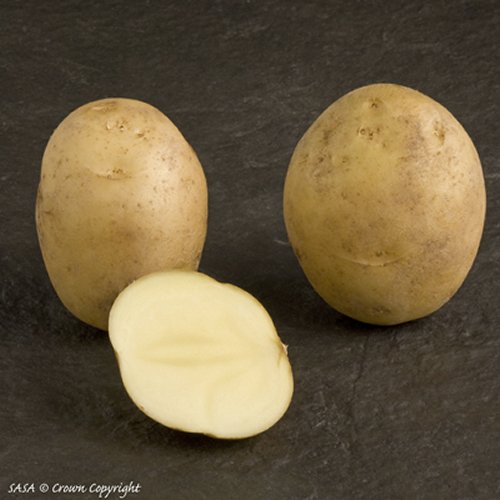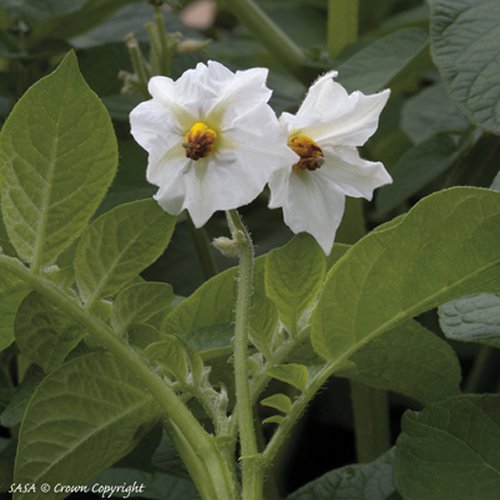Wilja are Second Early potatoes with parents Climax and KO 51-123. They were developed in Holland by Konst Research during the 1960's and first released there in 1975.
The aim behind developing this particular variety was to create a potato which bulked up early in the season and could be used as if it was a Maincrop.
Supermarkets in the UK sold this variety in large amounts during the 80s and 90s. They then replaced Wilja with the slightly better looking Estima.

Wilja Potatoes
The skin of Wilja potatoes is light brown and slightly rough (most will prefer to peel them before cooking), the flesh is light yellow. The texture is half way between waxy and floury which is why it is so good for all cooking purposes.
The potatoes are average sized when harvested at their normal time and most are of the same size. They produce a reasonable amount of potatoes per plant.
Wilja are an all-round potato for cooking purposes but excel at producing excellent roast potatoes early on in the season. It boils well and does not fall apart easily. Wilja stores well in the correct conditions.
They also make excellent baked potatoes. The Wilja "promise" that they can be grown large enough to form large baked potatoes is illustrated by the picture below.
We visited Hunscote Farm Shop in Warwickshire recently and they presented us with a fully grown Wilja potato (normal sized potato for comparison purposes) to prove just how big they really can grow - very large is the answer!
The taste of Wilja potatoes is first class, earthy and rich, just as most people want a late variety potato to taste. As well as boiling, they make top class roast potatoes, and earlier in the season compared to most other varieties.
Disease resistance is good overall, slugs avoid them completely and scab is very unlikely to affect Wilja potatoes. Blight resistance is average.
Wilja potatoes should be grown in the normal manner for Second Early potatoes. Click here for our detailed page about growing potatoes. The advice applies to growing potatoes in containers as well as in open ground.
The best time to chit / sprout Wilja potatoes is the first week of March in average areas of the UK.
Being a Second Early variety it is well worth chitting / sprouting Wilja potatoes - it will give a more reliable crop although not absolutely necessary. Click here for our advice on how and why to chit / sprout potatoes.
The best time to plant out chitted / sprouted Wilja potatoes is about the first week of April in average areas of the UK.
Planting out on this date will give the chitted / sprouted potatoes about four weeks before they reach the surface of the soil. Whilst they are growing towards the soil surface the sprouts will be protected from frost by the surrounding soil.
By the time they do appear above the soil, the danger of frost will have passed and the sprouts will not be damaged by frost.
As with all vegetables, the time for harvest is dependent on many factors such as the weather conditions while they are growing and the general soil conditions.
On average however you can expect to start harvesting Wilja potatoes in second week of July in average areas of the UK
Using the above date as a guide we would advise that a week before that date you use your hand to search through the soil to harvest one or two potatoes. The term often used for this activity is known in gardening circles as "furtling"!
It does almost no damage to the remaining potatoes but allows you to examine one or two of the potatoes to ensure they are of approximately the correct size. If they are, start harvesting, if not wait for two weeks and try again.

Wilja Potato Flowers
Harvesting Wilja potatoes can be spread over three to four weeks. Be sure to read our page on storing potatoes to get the most from your crop of Wilja potatoes.
We would recommend Charlotte as an alternative variety to Wilja. For other second early potatoes we have tested, select one from the drop down list below.
IF YOU HAVE ANY QUESTIONS OR COMMENTS
CONCERNING THIS PAGE, ENTER THEM BELOW.
WE WILL ANSWER ON
THIS PAGE AS SOON AS POSSIBLE